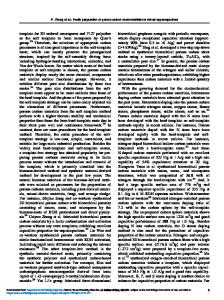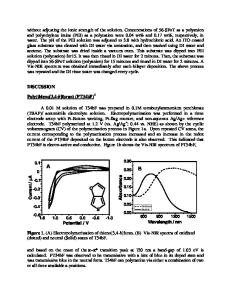Facile Preparation of Carbon-Nanotube-based 3-Dimensional Transparent Conducting Networks for Flexible Noncontact Sensin
- PDF / 383,696 Bytes
- 6 Pages / 432 x 648 pts Page_size
- 97 Downloads / 420 Views
Facile Preparation of Carbon-Nanotube-based 3-Dimensional Transparent Conducting Networks for Flexible Noncontact Sensing Device Yanlong Tai and Gilles Lubineau* King Abdullah University of Science and Technology (KAUST), Physical Sciences and Engineering Division, COHMAS Laboratory, Thuwal 23955-6900, Saudi Arabia *Corresponding author E-mail: [email protected] (Yanlong Tai), [email protected] (Gilles Lubineau) ABSTRACT Here, we report the controllable fabrication of transparent conductive films (TCFs) for moisture-sensing applications based on heating-rate-triggered, 3-dimensional porous conducting networks of single-walled carbon nanotube (SWCNT)/poly(3,4-ethylenedioxythiophene)polystyrene sulfonate (PEDOT:PSS). How baking conditions influence the self-assembled microstructure of the TCFs is discussed. The sensor presents high-performance properties, including a reasonable sheet resistance (2.1 kohm/sq), a high visible-range transmittance (> 69 %, PET = 90 %), and good stability when subjected to cyclic loading (> 1000 cycles, better than indium tin oxide film) during processing. Moreover, the benefits of these kinds of TCFs were verified through a fully transparent, highly sensitive, rapid response, noncontact moisturesensing device (5×5 sensing pixels). INTRODUCTION Flexible and transparent electronics (FTEs) will be integral to the next generation of electronics, for which classical silicon electronics are not suitable.1-3 Carbon-based transparent conductive films (TCFs) on plastic substrates are likely to be the essential components.4,5 They all not only exhibit high transparency across the visible light spectrum (Transmittance, up to 90%) and low sheet resistance (below 10 ohm/sq), but they also present excellent dynamic fatigue properties (above 1000 cycles).6 Carbon-based TCFs are affordable and show high stability upon exposure to high temperatures and ultraviolet light.7 Recently, interest towards improving carbon-based 3-dimensional (3D) porous conducting networks (3D-PCNs) is growing due to its significant features,8 as well as various applications.9 However, the present fabrication process of 3D-PCNs has a lot of limitations, 10,11 which have inspired the development of a more facile and effective method. Here, we develop single-walled carbon-nanotube-based porous transparent conductive films (SWCNT-PTCFs) using a facile and novel approach. First, stable and monodisperse SWCNT inks were prepared using poly(3,4-ethylenedioxythiophene)/polystyrene sulfonate (PEDOT:PSS). Second, SWCNT-PTCFs were fabricated by the drop casting method. How heating rate influences the self-assembled microstructure was systematically investigated. Our objective was to promote a transition from a 2-dimensional (2D) to a 3D microstructure of the conducting networks by increasing the heating rate throughout the baking process, allowing the fabrication of SWCNT-PTCFs to be controlled (Figure 1). Third, the efficiency of fabricated
3533 Downloaded from https:/www.cambridge.org/core. Columbia University Librarie
Data Loading...











